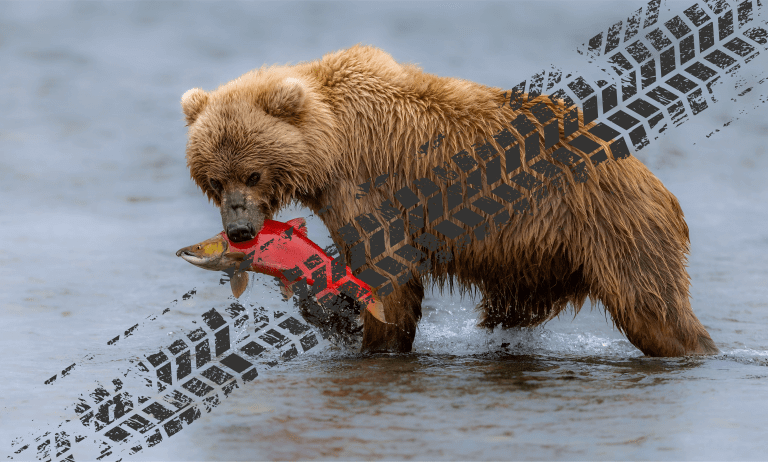

For Salmon, Tires May Be Just as Dangerous as Bears!
Salmon typically focus on their life cycle, swimming upstream to find a place to spawn while avoiding threats like grizzly bears and birds of prey. They also face the temptation of shiny objects, likely connected to anglers seeking the catch of the day. Unfortunately, these challenges are only part of their struggles. Salmon now also have to steer clear of a harmful chemical found in vehicle tires — something that seems quite out of place for these fish. While you probably won’t see salmon visiting a tire shop for a new set of radials, a transformation product of a chemical known as 6PPD, which has been used for decades to enhance tire durability, is making its way into waterways. This chemical has proven to be particularly toxic to salmon populations.
6PPD-Quinone Ecosystem Impacts
6PPD is the much more user-friendly moniker of N-(1,3-Dimethylbutyl)-N′-phenyl-p-phenylenediamine. Tiny rubber particles from tire wear react with ozone in the air to form 6PPD-quinone. Stormwater runoff from roads and parking lots can facilitate migration of 6PPD-quinone into waterways where it is toxic enough to kill some species of salmon after just a few hours of exposure.
In response to a petition submitted by several indigenous tribes of the Pacific Northwest aimed at prohibiting the use of 6PPD in tire manufacturing, the US EPA has issued an advance notice of proposed rulemaking (ANPRM) under Section 6 of the Toxic Substances Control Act (TSCA) to gather information on the potential risks of 6PPD and 6PPD-quinone, including environmental and human health effects, exposure pathways, and environmental persistence and bioaccumulation. In addition, US EPA is seeking information on 6PPD alternatives, as well as transformation products associated with potential alternatives. Information gathered via the ANPRM could be used to inform future regulatory action.
What’s Next in 6PPD-Quinone Regulation
Salmon populations are central to the ecosystems, Tribal cultures, and economies of the West Coast and have declined dramatically in recent decades. Numerous western fisheries currently have various salmon species classified as either threatened or endangered. Much of the Tribal population in the region relies on traditional subsistence diets and practices, with local waterways serving as a lifeline for these communities.
The link between 6PPD-quinone and salmon deaths was first established via US EPA-funded research in the Puget Sound region in 2020. The US EPA continues to support research to increase understanding of the impacts of 6PPD and 6PPD-quinone on the environment and human health. The Office of Water is developing an analytical method to detect 6ppd-quinone in stormwater and establishing screening levels to protect salmon and other aquatic organisms. In addition, by the end of 2024, US EPA plans to finalize a rule requiring manufacturers of 6PPD to report any unpublished health and safety studies.
The insights obtained from the ANPRM could play a pivotal role in advocating for the protection of the salmon population, which is essential for the food security of communities that rely on these fish as a key source of nutrition for their overall wellbeing. Stay tuned … In our next issue of The Standard (March 2025), we will be taking an even deeper dive into the issue of 6PPD. But in the meantime, please see the following resources for more information regarding 6PPD and the ANPRM.
Resources
US EPA. 6PPD-quinone https://www.epa.gov/chemical-research/6ppd-quinone. (Accessed November 2024).
US EPA. Advance Notice of Proposed Rulemaking on 6PPD and Its Transformation Product, 6PPD-quinone https://www.epa.gov/newsreleases/epa-grants-tribal-petition-protect-salmon-lethal-chemical. (Accessed November 2024).
US EPA. EPA Grants Tribal Petition to Protect Salmon from Lethal Chemical https://www.epa.gov/newsreleases/epa-grants-tribal-petition-protect-salmon-lethal-chemical. (Accessed November 2024).

